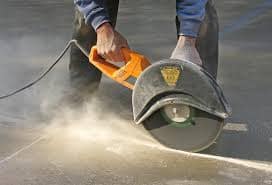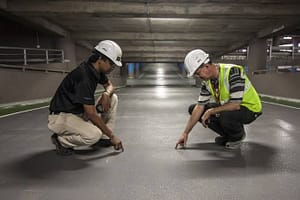Introduction
Concrete cutting is an essential part of the construction process. It allows builders to create openings for doors, windows, and other fixtures. However, cutting concrete at the wrong time can lead to a host of problems, including cracking, uneven surfaces, and weakened structures. This begs the question, when is it too late to cut concrete?
In this article, we’ll delve into this important question and provide you with a comprehensive guide to making the right decision. We’ll cover everything from the best time to cut concrete to the risks of cutting it too late. So, let’s get started!
When Is the Best Time to Cut Concrete?
Before we can discuss when it’s too late to cut concrete, it’s important to understand the best time to do it. Cutting concrete at the right time ensures a smooth and even finish without any cracks or damage. Here are some factors to consider:

Age of the Concrete
The age of the concrete is one of the most important factors to consider. The ideal time to cut concrete is when it has cured enough to be hard but is still fresh enough to prevent cracking. The general rule of thumb is to wait at least 24 hours after pouring the concrete before cutting it.
However, the exact timing may vary depending on the climate, humidity, and other environmental factors. For example, in hot and dry conditions, concrete may cure faster, while in cold and wet conditions, it may take longer. It’s best to consult with a professional concrete cutter to determine the best time for cutting.
Type of Concrete
The type of concrete is another factor to consider when deciding when to cut it. Different types of concrete have different curing times, and some may require special equipment or techniques to cut properly. For example, high-strength concrete may require diamond blades and special saws to cut, while lightweight concrete may be cut using a regular saw.
It’s important to consult with the concrete supplier or manufacturer to determine the optimal time and method for cutting the specific type of concrete used in your project.
Purpose of the Cut
The purpose of the cut is also a crucial factor to consider. If the cut is intended for a decorative purpose, such as creating patterns or designs, it may be best to wait until the concrete has fully cured and hardened. However, if the cut is necessary for functional reasons, such as creating an opening for a door or window, it may be necessary to cut it earlier.

Consult with a professional concrete cutter to determine the best time for cutting based on the purpose of the cut.
When Is It Too Late to Cut Concrete?
Now that we’ve covered the best time to cut concrete, let’s discuss when it’s too late. Cutting concrete too late can result in a host of problems, including:
- Cracks and fractures
- Uneven surfaces
- Weakened structures
- Difficulty in cutting
- Increased costs
Here are some factors that can make it too late to cut concrete:
Concrete Has Fully Cured
If the concrete has fully cured and hardened, it may be too late to cut it. At this point, any attempts to cut it may result in cracks, fractures, and uneven surfaces. Cutting fully cured concrete can also weaken the structure and compromise its integrity.
Weather Conditions
Weather conditions can also play a role in determining when it’s too late to cut concrete. If the weather is too hot or too cold, it can affect the curing process and make it difficult to cut the concrete. In some cases, extreme weather conditions may also cause the concrete to crack or warp, making it too late to cut.
Other Factors
Other factors that can make it too late to cut concrete include:
- Improper mixing or curing of the concrete
- Presence of reinforcing steel or other materials that make it difficult to cut
- Changes in the project requirements or design that make the cut unnecessary
FAQs
Q: How long should I wait before cutting newly poured concrete?
A: It’s generally recommended to wait at least 24 hours before cutting newly poured concrete. However, the exact time may vary depending on environmental factors and the type of concrete used.
Q: Can I cut concrete that has already cured?
A: It’s not recommended to cut concrete that has already fully cured and hardened. Doing so can result in cracks, fractures, and weakened structures.
Q: What equipment do I need to cut concrete?
A: The equipment needed to cut concrete may vary depending on the type of concrete and the purpose of the cut. Some common tools used for cutting concrete include diamond blades, concrete saws, and handheld grinders.
Q: How do you compact concrete without a vibrator?
A:
Compacting concrete without a vibrator can be challenging, as a vibrator is a commonly used tool to ensure proper consolidation. However, if a vibrator is not available, there are alternative methods you can try to compact the concrete effectively. Here are a few options:
- Rodding: Rodding involves using a long, thin rod or a bar to manually push the concrete into place. Insert the rod vertically into the concrete and push it down while slowly rotating it to ensure even distribution and consolidation. Repeat this process in a grid pattern throughout the concrete.
- Tamping: Tamping can be done using handheld tools like a wooden or rubber mallet. It is most effective for small-scale applications or areas that are difficult to access. Use the mallet to gently tap the concrete surface, working across the entire area to compact it.
- Screeding: Screeding is the process of leveling and smoothing the concrete surface. While it may not provide the same level of compaction as a vibrator, it helps to eliminate air pockets and achieve a more even surface. Use a screed board (a straight piece of wood or metal) to level the concrete by pulling it across the surface in a sawing motion.
- Gravity compaction: This method is suitable for low-height concrete placements. Pour the concrete in layers, and allow the weight of the fresh concrete to help consolidate the layer below. Gently drop the concrete from a low height to encourage settlement and remove air voids. Repeat the process for subsequent layers.
Remember, while these alternative methods can aid in compacting concrete, they may not achieve the same level of compaction as a vibrator. It’s crucial to ensure that proper techniques and practices are followed to maintain the structural integrity and durability of the concrete. If possible, it is recommended to use a vibrator for optimal results.
Cutting concrete is an essential part of the construction process, but it’s important to do it at the right time to avoid costly mistakes. Waiting too long to cut concrete can result in a host of problems, including cracking, uneven surfaces, and weakened structures.
By considering factors such as the age and type of concrete, the purpose of the cut, and environmental conditions, you can make an informed decision on when to cut your concrete. Consulting with a professional concrete cutter can also help ensure that you make the right decision and avoid making costly mistakes. So, when is it too late to cut concrete? The answer is, it depends.